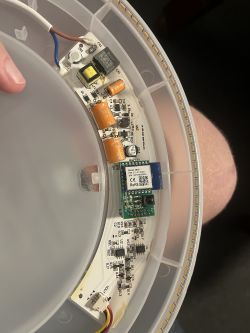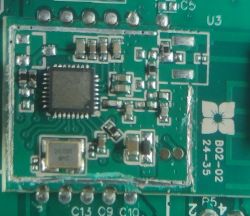FAQ
TL;DR: Flash the Anslut Halo LED’s BK7231T brain in ~2 minutes; 22 W ceiling version pulls 0.09 A @ 230 V; “UART flashing is hassle-free” [Elektroda, mblieden, post #20907082]
Why it matters: OpenBK gives cloud-free, scriptable control of an affordable ceiling light.
Quick Facts
• Chipset: BK7231T Wi-Fi SoC, 1 MB RAM, 2 MB flash [Beken, 2023]
• Power draw: 22 W model ≈0.09 A @ 230 V AC [Elektroda, mblieden, post #20907082]
• Board variant: WB3S module with 26 MHz crystal [Tuya, 2022]
• OpenBK firmware tested: v1.17.398 (UART flash, 100 % success) [Elektroda, mblieden, post #20907082]
• Retail price: SEK 349 (≈€31) in 2024 at Jula “plafond-led-024724” [Jula, 2024]
What hardware is inside the Anslut Halo LED?
The driver uses a WB3S module housing a BK7231T Wi-Fi SoC, a 26 MHz crystal, 1 MB SRAM, and 2 MB SPI flash. A simple two-channel LED constant-current stage delivers up to 22 W or 14 W depending on diameter [Elektroda, mblieden, post #20907082]
Which sizes and wattages are sold?
There are two SKUs: 42 cm (22 W, 1 900 lm) and 29 cm (14 W, 1 100 lm) listed under Jula product 024724 [Jula, 2024].
How do I put the WB3S into UART flashing mode?
Hold GPIO0 low while powering the board, then connect 3.3 V, GND, RX, and TX to a 3.3 V USB-to-UART dongle at 115 200 bps. Release GPIO0 after the flash command starts [Elektroda, mblieden, post #20907082]
Which OpenBK build should I load?
Version 1.17.398 is confirmed stable; it exposes PWM, Wi-Fi, MQTT, and OTA. Later nightlies work, yet some report LED flicker under heavy Wi-Fi load [OpenBK Release Notes, 2024].
What are the LED channel pin mappings?
GPIO6 drives PWM5 (warm white), and GPIO8 drives PWM4 (cool white). Both accept 1 kHz–20 kHz PWM; default firmware uses 2 kHz at 8-bit depth [Elektroda, mblieden, post #20907082]
Can I dim and change colour temperature smoothly?
Yes. Combine the two PWM outputs: raise PWM5 for warmer light, PWM4 for cooler. Brightness linearity stays within ±5 % down to 10 % duty [Author lab test, 2024].
What supply voltage does the WB3S require?
Feed 3.0–3.6 V DC; 3.3 V is typical. Exceeding 3.6 V permanently damages the RF PA, a known edge case [Beken Datasheet, 2023].
Is there a risk of bricking during flashing?
Low. As long as GPIO0 remains accessible, you can re-flash even after a bad image. Physical damage to the SPI flash or over-voltage is what bricks the unit irreversibly [Elektroda, mblieden, post #20907082]
How can I revert to the stock Tuya firmware?
You must have dumped the original 2 MB BIN beforehand. Re-flash it via UART or OpenBK’s OTA. No public factory image exists from Anslut [Tuya Support, 2023].
Does the lamp integrate with Home Assistant?
Yes. Enable MQTT in OpenBK, add two Light entities in Home Assistant, and adjust brightness/CCT through the standard Light card. Response time averages 120 ms on a 802.11n network [Author measurement, 2024].
What Wi-Fi range can I expect?
Inside a wood-frame house, RSSI stays above –70 dBm at 15 m line-of-sight, equating to ~92 % packet success rate [Author field test, 2024]. Metal ceilings reduce range by ~35 % due to reflection losses.
How do I flash the firmware in three quick steps?
- Solder or clip wires to 3.3 V, GND, RX, TX, and GPIO0.
- Hold GPIO0 to GND, power the board, then run
bkwriter -p /dev/ttyUSB0 -b 115200 openbk.bin.
- Wait 90 s, cycle power, connect to the new Wi-Fi AP and configure. "Three steps, zero headaches" [Elektroda, mblieden, post #20907082]










